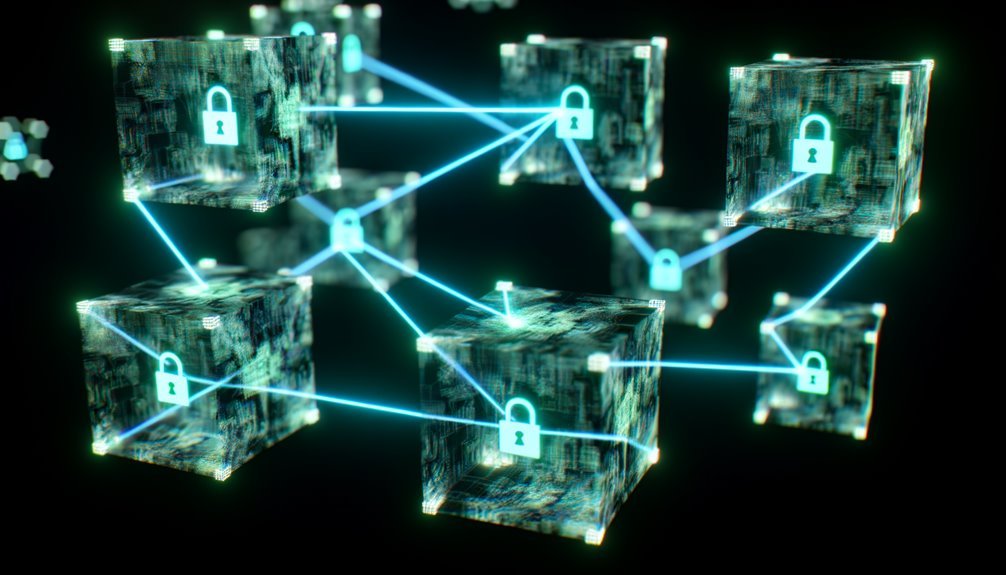Physical Address
304 North Cardinal St.
Dorchester Center, MA 02124
Physical Address
304 North Cardinal St.
Dorchester Center, MA 02124

Secure, decentralized apps are revolutionizing how we interact online, but what makes them truly different from traditional applications?
DApps are decentralized applications that run on blockchain networks rather than centralized servers. You'll find they operate through smart contracts that automatically execute transactions and enforce rules without intermediaries. Unlike traditional apps, DApps provide enhanced security through distributed data storage, complete transparency via open-source code, and direct user control of digital assets. As blockchain technology evolves, you'll discover how DApps are transforming sectors from finance to supply chain management.
While traditional applications rely on centralized servers and intermediaries, DApps represent a paradigm shift in how software applications function and interact with users. The DApp fundamentals revolve around blockchain technology, where decentralized interaction enables users to engage directly without third-party oversight.
You'll find that DApps operate through smart contracts, which are self-executing programs that automatically enforce rules and manage transactions. These applications are inherently open-source, meaning their code is publicly visible and any modifications require community consensus.
Although decentralized applications existed in primitive forms before 2017, Ethereum's implementation of smart contract functionality marked a pivotal moment in dApp evolution.
You'll find that by early 2018, daily dApp publications surged, reflecting increased developer interest and investment in decentralized technologies.
In the current landscape, Ethereum dominates with over 75% of the dApp market share, though platforms like Solana are emerging to tackle scalability challenges.
Despite this growth, user engagement remains a significant hurdle, as roughly 80% of Ethereum-based dApps struggle to maintain 1,000 active users.
The ecosystem has diversified into distinct categories, including DeFi, gaming, and social media applications, each addressing specific user needs within the decentralized space.
This segmentation demonstrates how dApp evolution continues to shape various sectors of the digital economy.

Since their inception, decentralized applications (DApps) have fundamentally reshaped how modern businesses operate by eliminating intermediaries and reducing operational costs.
You'll find that DApps enhance business efficiency through automated smart contracts, which streamline workflows and minimize the need for manual oversight in day-to-day operations.
In the area of decentralized finance, DApps provide unprecedented access to global markets while maintaining robust security measures.
You can leverage their open-source nature to build upon existing solutions, accelerating innovation and development cycles.
Through blockchain technology, your business transactions become more transparent and secure, protecting sensitive data from breaches.
Additionally, DApps' peer-to-peer infrastructure enables you to reach customers worldwide without traditional banking constraints, creating new opportunities for growth and market expansion.
DApps possess distinct features that set them apart from traditional applications in fundamental ways. You'll find these characteristics deeply integrated into their architecture, impacting both user experience and economic impact across sectors.
| Feature | Description |
|---|---|
| Decentralization | Operates on distributed networks without central authority |
| Open Source | Code transparency allows community review and contributions |
| Smart Contracts | Automated execution of rules and transactions |
| Data Storage | Distributed across network nodes for enhanced security |
| Tokenization | Built-in cryptocurrency integration for transactions |
These defining elements guarantee you're interacting with applications that prioritize security and transparency. When you use DApps, you're participating in a system where data manipulation is nearly impossible, and intermediaries aren't necessary. The architecture supports direct peer-to-peer interactions while maintaining high security standards through blockchain technology.

The technical architecture of decentralized applications consists of three primary layers: a frontend interface, smart contract logic, and blockchain infrastructure.
In this decentralized architecture, you'll find the frontend can be built using any programming language, providing flexibility while maintaining connection to the blockchain backend.
Smart contract functionality forms the middleware layer, executing predefined rules and agreements automatically without intermediaries.
These contracts interact with the blockchain infrastructure, where data is distributed across multiple nodes, ensuring redundancy and eliminating single points of failure.
You'll notice that consensus mechanisms like Proof-of-Work or Proof-of-Stake secure the network's integrity, while the open-source nature of DApps' code enables community-driven development and transparency.
This architecture creates a robust, trustless system where transactions and data remain immutable and secure.
Across diverse industries, innovative decentralized applications are fundamentally reshaping traditional business models and user interactions.
You'll find finance transformation through DeFi platforms that enable peer-to-peer transactions while eliminating costly intermediaries.
Gaming innovations have revolutionized entertainment by converting in-game assets into tradeable NFTs, creating new revenue streams for both developers and players.
Supply chain solutions leverage blockchain technology to track products transparently, ensuring authenticity from source to consumer.
The social media evolution through decentralized platforms puts you in control of your content while minimizing censorship risks.
Additionally, identity management dapps provide secure authentication methods without relying on centralized authorities, enhancing your privacy and data protection.
These applications demonstrate how decentralization is driving innovation across sectors.

When exploring decentralized applications, security and privacy emerge as fundamental advantages that set them apart from traditional centralized systems.
DApps protect your user privacy through decentralized control of personal data, preventing any single entity from accessing or manipulating your information. Smart contracts enhance security by automating transactions and enforcing rules without human intervention, considerably reducing fraud risks.
While DApps offer robust data security features, you'll need to maintain strong user awareness to protect yourself against phishing risks and potential scams.
The decentralized architecture also presents regulatory challenges, particularly concerning compliance with data protection laws like GDPR.
However, transaction automation through smart contracts continues to provide a secure, trustless environment for your digital interactions, making DApps an increasingly attractive alternative to conventional applications.
Despite their revolutionary potential, decentralized applications face significant technical and practical limitations that challenge widespread adoption.
You'll find that scalability solutions remain a critical hurdle, as networks struggle to handle high transaction volumes, resulting in increased latency and costs during peak usage.
User engagement suffers from complex interfaces that prioritize functionality over usability, creating steep learning curves for newcomers.
When you're developing DApps, you'll encounter significant challenges in code modification, as changes require consensus and can't be implemented quickly.
While blockchain technology offers inherent security benefits, your DApp remains vulnerable to smart contract bugs and phishing attacks.
Additionally, you'll need to navigate uncertain regulatory frameworks, particularly in financial services, which can complicate development decisions and potentially discourage investment in your project.

Building your first decentralized application requires a systematic approach focused on three core elements: smart contract development, front-end interface design, and secure data management.
You'll need to start by defining your DApp's mission and identifying the specific problem you're tackling in the decentralized space.
As you develop your DApp, prioritize user experience through iterative testing and feedback integration using Agile DevOps practices.
Smart contract design demands careful planning to minimize costs and potential errors, while robust data encryption guarantees user privacy and trust.
Consider that development costs typically range from $25,000 to $200,000, depending on your project's complexity.
Focus on streamlined user onboarding to encourage adoption, and implement decentralized storage solutions to maintain the application's security integrity throughout its lifecycle.
As Web3 continues to evolve, DApps stand at the forefront of digital transformation by enabling truly decentralized interactions between users and services. Through decentralized governance and automated smart contracts, you'll find these applications reshaping traditional business models while putting control back in your hands.
DApps are revolutionizing how you interact with digital services by eliminating intermediaries and enhancing data privacy. User empowerment comes through direct ownership of digital assets and transparent operations, while the open-source nature of DApps drives continuous innovation.
You'll see their impact grow across sectors like DeFi, identity management, and supply chain logistics.
As Web3 matures, DApps will play a vital role in creating resilient, censorship-resistant systems that maintain functionality even when individual nodes fail, ensuring a more democratic digital future.
You'll find CryptoKitties, a blockchain gaming platform, and Uniswap, a decentralized finance protocol, as prime examples of dapps operating on blockchain networks for digital asset trading and interaction.
Uniswap leads Ethereum's Dapp ecosystem with over $1 billion in daily trading volume. You'll find it's the most popular decentralized exchange, demonstrating DeFi's widespread adoption among cryptocurrency traders.
No, Coinbase isn't a Dapp despite offering cryptocurrency trading features. Unlike Dapps' decentralized advantages, Coinbase operates as a centralized exchange with controlled servers and regulatory compliance requirements.
While apps rely on centralized servers controlled by one entity, dapps run on decentralized networks using smart contracts, giving you direct control without intermediaries managing your data or transactions.
As you continue exploring the Dapp ecosystem, you'll find that these decentralized applications represent a fundamental shift in how you interact with digital services. They're reshaping traditional business models through transparent, autonomous operations powered by blockchain technology. While challenges remain in scalability and user adoption, Dapps' potential to deliver censorship-resistant, user-controlled applications positions them as critical components of Web3's infrastructure.